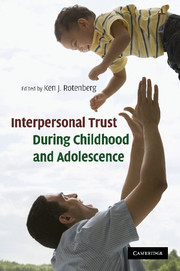Book contents
- Frontmatter
- Contents
- List of figures
- List of tables
- List of contributors
- Section I Conceptual foundations and issues
- Section II Childhood
- Section III Adolescence and early adulthood
- 10 Trust, but verify: Knowledge, disclosure, and mothers' beliefs about adolescents' trustworthiness
- 11 The role of trust in adolescent–parent relationships: To trust you is to tell you
- 12 A new scale for the assessment of adolescents' trust beliefs
- 13 A friend in need is a friend indeed: Exploring the relations among trust beliefs, prosocial tendencies, and friendships
- 14 Promoting intergroup trust among adolescents and young adults
- Index
- References
14 - Promoting intergroup trust among adolescents and young adults
Published online by Cambridge University Press: 04 August 2010
- Frontmatter
- Contents
- List of figures
- List of tables
- List of contributors
- Section I Conceptual foundations and issues
- Section II Childhood
- Section III Adolescence and early adulthood
- 10 Trust, but verify: Knowledge, disclosure, and mothers' beliefs about adolescents' trustworthiness
- 11 The role of trust in adolescent–parent relationships: To trust you is to tell you
- 12 A new scale for the assessment of adolescents' trust beliefs
- 13 A friend in need is a friend indeed: Exploring the relations among trust beliefs, prosocial tendencies, and friendships
- 14 Promoting intergroup trust among adolescents and young adults
- Index
- References
Summary
Intergroup trust might be broadly defined as a positive expectation about the intentions and behavior, and thus trust, of an outgroup towards the ingroup (Lewicki, McAllister, and Bies, 1998). According to Rotenberg and colleagues' framework of interpersonal trust (e.g., Rotenberg, 1991; Rotenberg and Morgan, 1995; Rotenberg, Fox, Green, Ruderman, Slater, Stevens, and Carlo, 2005), trust consists of three important components: reliability, emotionality, and honesty. In an intergroup context, reliability refers to whether promises made by the outgroup are fulfilled; emotionality refers to whether the outgroup refrains from causing emotional harm to the ingroup; and honesty refers to whether the outgroup is perceived as telling the truth, and behaving in a benign rather than in a malicious or manipulative way towards the ingroup.
Trust is crucial if society is to function effectively, because the formation and maintenance of interpersonal relationships is dependent on our ability to trust one another (e.g., Rotenberg, 1991; Rotter, 1980). Our ability to trust others has diverse psychological consequences, particularly among children. According to attachment theory, the quality of a child's relationship with their caregivers can affect their beliefs about whether others are trustworthy and, subsequently, their ability to have successful relationships (Bridges, 2003). Similarly, it is important for children that they are able to trust their peers, and know that they will be honest, reliable, and benevolent (Bernath and Feshbach, 1995).
- Type
- Chapter
- Information
- Interpersonal Trust during Childhood and Adolescence , pp. 295 - 321Publisher: Cambridge University PressPrint publication year: 2010
References
- 6
- Cited by



